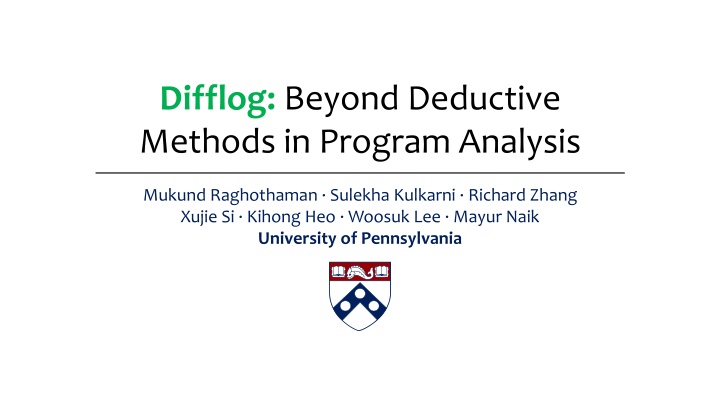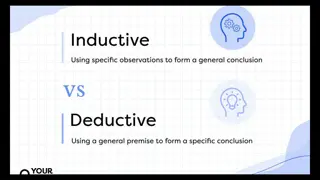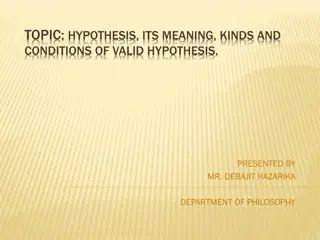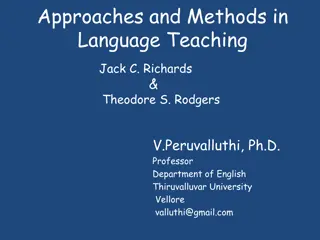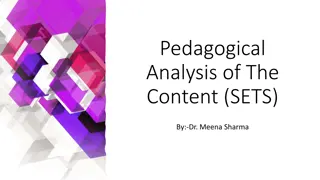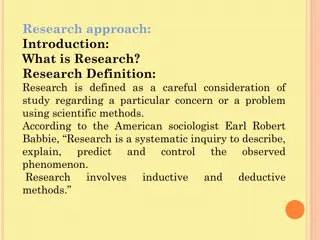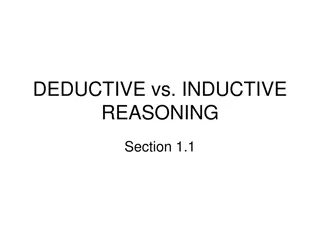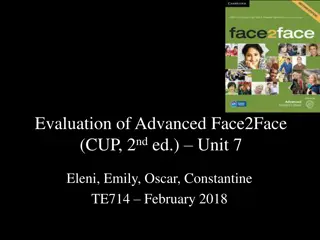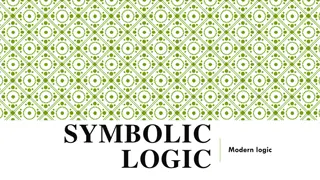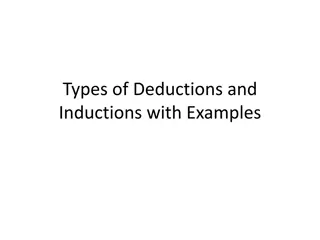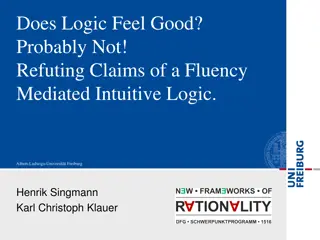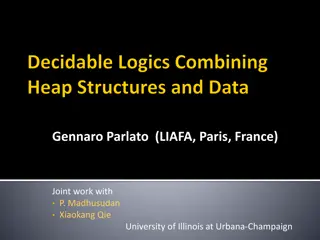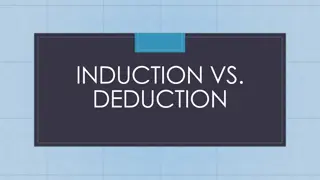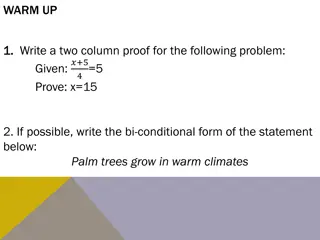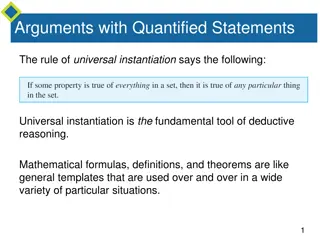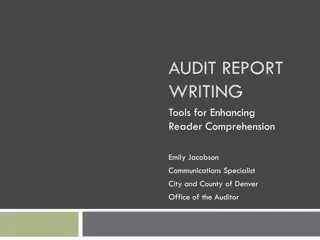Advancements in Program Analysis Beyond Deductive Methods
Explore the evolution of program analysis beyond deductive methods with innovative tools like static analyzers and data-driven analysis design. Discover the challenges faced, such as undecidable analysis questions and scalability issues, and the strategies employed to address them. Learn about the significant impact of approximations in static analysis and the importance of feedback-driven learning in enhancing the accuracy of bug detection and alarm prioritization.
Uploaded on Sep 10, 2024 | 2 Views
Download Presentation

Please find below an Image/Link to download the presentation.
The content on the website is provided AS IS for your information and personal use only. It may not be sold, licensed, or shared on other websites without obtaining consent from the author.If you encounter any issues during the download, it is possible that the publisher has removed the file from their server.
You are allowed to download the files provided on this website for personal or commercial use, subject to the condition that they are used lawfully. All files are the property of their respective owners.
The content on the website is provided AS IS for your information and personal use only. It may not be sold, licensed, or shared on other websites without obtaining consent from the author.
E N D
Presentation Transcript
Difflog: Beyond Deductive Methods in Program Analysis Mukund Raghothaman Sulekha Kulkarni Richard Zhang Xujie Si Kihong Heo Woosuk Lee Mayur Naik University of Pennsylvania
Static Analyzers Automatic bug-finding tools Astr e Microsoft Windows Device Drivers Airbus Avionics Software The ideal static analyzer: Identifies the most serious bugs Produces no false alarms Scales to very large codebases Facebook Mobile Applications Synopsis Enterprise Applications MLP 2018 Beyond Deductive Methods in Program Analysis 2
Heartbleed Buffer over-readbug in OpenSSL s Heartbeat implementation Introduced in 2011, discovered in 2014 Estimated to affect nearly 66% of all web servers Why did static analysis tools not discover the Heartbleed bug? MLP 2018 Beyond Deductive Methods in Program Analysis 3
Approximations in Static Analysis Challenge #1: Most analysis questions are undecidable So, analysis tools are only approximately correct Challenge #2: Tools must scale to large programs So, analysis designers make aggressive tradeoffs Coverity, On Detecting Heartbleed with Static Analysis, 2014 can be difficult to do without introducing large numbers of false positives, or scaling performance exponentially poorly. In this case, balancing these and other factors in the analysis design caused us to miss the defect. Relevant Alarms Unsound Incomplete Yes No Reported Yes True positive False positive No False negative True negative MLP 2018 Beyond Deductive Methods in Program Analysis 4
Program Analysis, Traditionally Program, ? Datalog Solver Analysis, ? Reports, ? Programmer Analysis Designer MLP 2018 Beyond Deductive Methods in Program Analysis 5
Our Contribution Training corpus {?1,?2, ,??} Data-driven analysis design Program, ? Feedback, ? Difflog Learning Learning Difflog Inference Inference Difflog Difflog Analysis, ? Programmer Analysis Designer Ranked reports, ? Alarm prioritization Generalization from feedback Training labels {?1,?2, ,??} MLP 2018 Beyond Deductive Methods in Program Analysis 6
Anatomy of an Analysis: Datarace Detection If ?1 and ?2 may execute in parallel, and ?3 may execute immediately after ?2, par(?1, ?3) par(?1, ?2), next(?2, ?3). R :- then ?1 and ?3 may themselves execute in parallel. Example of deduction rule in Datalog par(L1, L2) next(L2, L3) z = y + 1; // L2 z = z + 1; // L3 R Semmle x = y + 1; // L1 par(L1, L3) MLP 2018 Beyond Deductive Methods in Program Analysis 7
Applying the Analysis 1. Start with input tuples par(L1, L2) next(L2, L3) 2. Apply rules to derive new tuples R R next(L3, L4) next(L3, L2) par(L1, L3) R alias(L1, L3) 3. Stop when nothing new can be concluded R par(L1, L4) alias(L1, L4) R race(L1, L3) race(L1, L4) MLP 2018 Beyond Deductive Methods in Program Analysis 8
Applying the Analysis Possible datarace on field isPasv between lines Connection.java:191 (Read) and Connection.java:106(Write) Checker Of Races and Deadlocks: Popular static analysis tool for Java (Naik et al PLDI 2006) Highly concurrent open source FTP server [150 kLOC] 522 alarms 75 true positives 447 false positives MLP 2018 Beyond Deductive Methods in Program Analysis 9
How do False Alarms Arise? This rule causes incompleteness! par(?1, ?3) par(?1, ?2), next(?2, ?3). R :- if (numThreads == 1 /* L2 */) { x = x + 1; // L3 } x = x + 1; // L1 par(L1, L2) next(L2, L3) R par(L1, L3) MLP 2018 Beyond Deductive Methods in Program Analysis 10
How do False Alarms Arise? Incorrect intermediate conclusions lead to false alarms downstream Traditional solution: Refine the analysis, use more elaborate rules Requires domain expertise Makes analysis computationally expensive Effectiveness depends on program and on coding idioms MLP 2018 Beyond Deductive Methods in Program Analysis 11
Our Observation Alarms share root causes Therefore, they are correlated in their ground truth par(L1, L2) next(L2, L3) R R next(L3, L4) next(L3, L2) par(L1, L3) par(L1, L3) R alias(L1, L3) R par(L1, L4) par(L1, L4) alias(L1, L4) R race(L1, L3) race(L1, L3) How to generalize from race(L1, L3)? By preserving the provenance of alarms! race(L1, L4) race(L1, L4) MLP 2018 Beyond Deductive Methods in Program Analysis 12
Interactive Ranking and Marginal Inference Training corpus {?1,?2, ,??} Program, ? Feedback, ? Difflog Learning Learning Difflog Inference Inference Difflog Difflog Analysis, ? Programmer Analysis Designer Ranked reports, ? Training labels {?1,?2, ,??} R., Kulkarni, Heo, Naik. PLDI 2018. MLP 2018 Beyond Deductive Methods in Program Analysis 13
Marginal Inference and Interactive Ranking How do we extract this probabilistic model? Pr(a) Pr(a a1) Pr(a a1, a2) Pr(a a1, a2,a3) a1 a3 a2 0.993 0.046 0.779 MLP 2018 Beyond Deductive Methods in Program Analysis 14
A Probabilistic Model of Alarms This rule causes incompleteness! par(?1, ?3) par(?1, ?2), next(?2, ?3). R :- Quantifies incompleteness par(L1, L2) next(L2, L3) Even if both par(L1,L2) and next(L2,L3) hold, we only believe par(L1,L3) with confidence 0.95. confidence 0.95. Even if both par(L1, L2) and next(L2, L3) hold, we only believe par(L1, L3) with R par(L1, L3) Pr(par(L1, L3) | ?) Pr( par(L1, L3) | ?) ? = par(L1, L2) next(L2, L3) 0.95 0.05 ? = (par(L1, L2) next(L2, L3)) 0 1 MLP 2018 Beyond Deductive Methods in Program Analysis 15
Joint probability distribution over ground truth of all tuples induced by factoring: A Probabilistic Model of Alarms Pr(race(L1, L4), par(L1, L4), alias(L1, L4), ) = Pr(race(L1, L4) | par(L1, L4), alias(L1, L4)) Pr( par(L1, L4) | ) Pr(alias(L1, L4)) [Factor ] [Factor ] [Factor ] par(L1, L2) next(L2, L3) R R Factor next(L3, L4) next(L3, L2) par(L1, L3) Each tuple treated as a Boolean-valued random variable R alias(L1, L3) Factor R par(L1, L4) alias(L1, L4) R race(L1, L3) race(L1, L4) Factor MLP 2018 Beyond Deductive Methods in Program Analysis 16
Experimental Evaluation Analysis 1: Datarace analysis for Java programs Analysis 2: Taint analysis for Android apps Suite of 16 benchmarks: Dacapo and Android malware 40K 616KLOC MLP 2018 Beyond Deductive Methods in Program Analysis 17
Effectiveness of Ranking Hundreds of alarms, tens of true positives Datarace Taint With Bingo, the user needs to inspect 69% fewer false alarms 100% 393 940 110 1870 420 257 817 437 152 978 352 212 156 958 30 522 75% 50% Dramatic reductions in inspection burden 25% 0% Xalan App-324 Sunflow App-kQm Jspider Tilt Mazes Noisy Sounds Ginger Master FTP HEDC Weblech App-ca7 LUIndex Andors Trail App-018 Avrora True positives Bingo Total MLP 2018 Beyond Deductive Methods in Program Analysis 18
Training corpus {?1,?2, ,??} Program, ? Feedback, ? Difflog Difflog Learning Learning Difflog Difflog Inference Inference Analysis, ? Programmer Analysis Designer Ranked reports, ? Training labels {?1,?2, ,??} R., Zhang, Si, Heo, Naik. In submission, 2018. MLP 2018 Beyond Deductive Methods in Program Analysis 19
From the Discrete to the Continuous Rule weights induce numerical values for each conclusion pt(?, ?) pt(?, ?) ? &? . ? &? . R1 R1 :- :- 0.90 pt(?, ?) pt(?, ?) ? ? , pt(?, ?). ? ? , pt(?, ?). R2 R2 :- :- 0.60 pt(?, ?) pt(?, ?) ? *? , pt(?, ?), pt(?, ?). ? *? , pt(?, ?), pt(?, ?). R3 R3 :- :- 0.80 Ideally, 1.0 for true positives and 0.0 for false alarms pt(?, ?) pt(?, ?) *? ? , pt(?, ?), pt(?, ?). *? ? , pt(?, ?), pt(?, ?). R4 R4 :- :- 0.70 pt(b1, c1) pt(b1, c1) pt(a, b1) pt(a, b1) pt(b1, c2) pt(b1, c2) pt(k, c1) pt(k, c1) pt(k, c2) pt(k, c2) Can we optimize for these values? 0.90 0.90 0.90 0.65 0.65 MLP 2018 Beyond Deductive Methods in Program Analysis 20
From the Discrete to the Continuous Main challenge: Gradient descent would be very expensive Because marginal inference is #P-complete Because independence assumptions don t always hold Solution: Evaluate values using the Viterbi semiring instead ??= max (?? ??1 ??2 ???) ??= (??1 ??2 ???) ? ? MLP 2018 Beyond Deductive Methods in Program Analysis 21
Experimental Performance Si, Lee, Zhang, Albarghouthi, Koutris, Naik. FSE 2018. # Relations # Rules Time (s) Input Output Expected Candidates Difflog ALPS Andersen 4 1 4 27 4 148 Escape 4 3 6 26 3 10 Mod/Ref 7 5 10 30 99 5307 Ancestor 2 2 4 38 3 25 Animals 9 4 4 76 22 76 Dramatic improvements in synthesis time over state-of-the-art MLP 2018 Beyond Deductive Methods in Program Analysis 22
Conclusion Difflog: Framework to extend Datalog to continuous domains Builds on theory of semiring provenance Associates rules with tokens and computes provenance of alarms Naturally captures alarm correlations Enables data-driven analysis design Interactive alarm prioritization MLP 2018 Beyond Deductive Methods in Program Analysis 23
Future Directions Continuous integration and incremental analyses Fault localization in complex systems Combining numerical optimization and CDCL MLP 2018 Beyond Deductive Methods in Program Analysis 24
